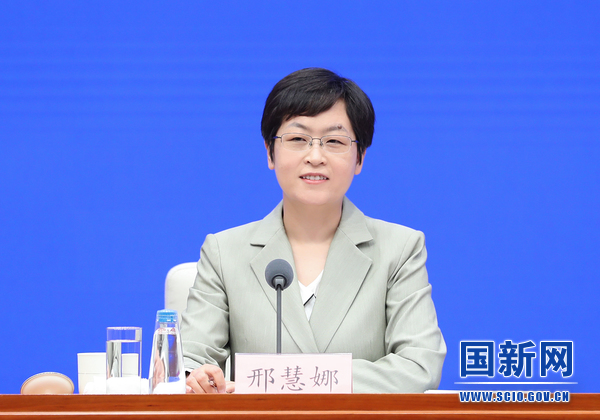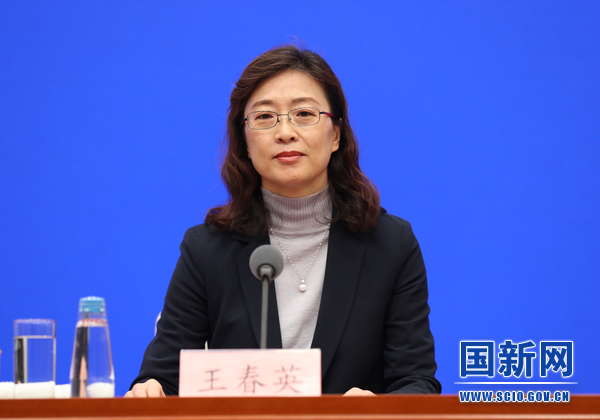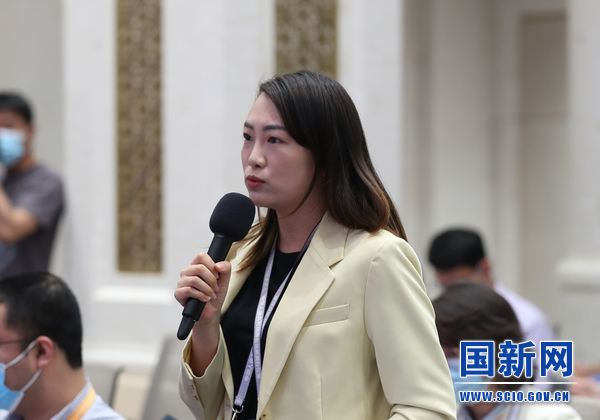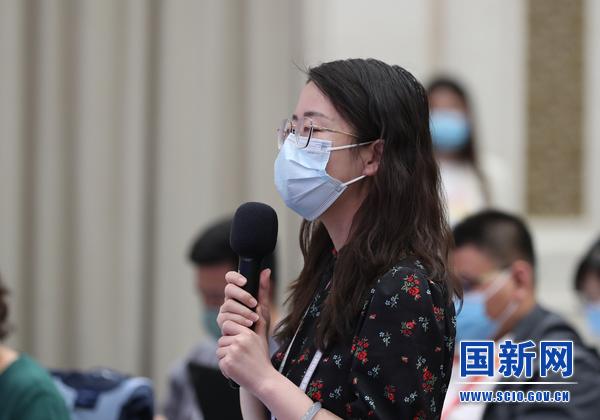
Xing Huina (Photographed by Liu Jian)
Xing Huina, Deputy Head of the Press Bureau of the State Council Information Office (SCIO) and Spokesperson for the SCIO:
Ladies and gentlemen, good afternoon! Welcome to this press conference of the SCIO, and we will continue with the regular economic data release. We are pleased to welcome Ms. Wang Chunying, Deputy Administrator and Press Spokesperson of the SAFE. She will share with us the data on China’s foreign exchange receipts and payments for the first quarter of 2022 and answer your questions.
Now I will give the floor to Ms. Wang.
2022-04-22 15:00:28

Wang Chunying (Photographed by Xu Xiang)
Wang Chunying, Deputy Administrator and Press Spokesperson of the SAFE:
Good afternoon, everyone. Welcome to today’s press conference. First, I would like to brief you on China’s foreign exchange receipts and payments situations for the first quarter of 2022 and then I will take your questions.
In the first quarter of 2022, the COVID-19 pandemic continued to disrupt the global economy while the international political and economic environment were intertwined with uncertainties and unstable factors, and as a result the volatility in the international financial market became intensified. However, China’s economy has continued to recover and operate within a reasonable range on the whole. China’s foreign exchange market was generally stable. The renminbi exchange rate against the US dollar went through ups and downs but remained basically stable. The cross-border capital flow ran at an overall stable and balanced level.
According to the data on foreign exchange settlement and sales by banks in the first quarter of 2022, in US dollar terms, banks settled US$660.3 billion and sold US$601.5 billion of foreign exchange, representing a surplus of US$58.7 billion. In renminbi terms, banks settled 4.2 trillion yuan and sold 3.8 trillion yuan of foreign exchange, representing a surplus of 373.1 billion yuan. For cross-border receipts and payments by non-banking sectors, in dollar terms, banks registered US$1.5767 trillion in foreign-related receipts and US$1.5145 trillion in foreign-related payments for customers, representing a surplus of US$62.2 billion; or in renminbi terms, banks handled foreign-related receipts of 10.0 trillion yuan and payments of 9.6 trillion yuan for customers, recording a surplus of 395.7 billion yuan.
China’s foreign exchange receipts and payments for the first quarter of 2022 present the following characteristics:
First, banks maintained a reasonable surplus in the foreign exchange settlement and sales by banks, as well as in the cross-border receipts and payments. In the first quarter of 2022, the foreign exchange settlement and sales by banks recorded a surplus of US$58.7 billion, while the cross-border receipts and payments by non-banking sectors recorded a surplus of US$62.2 billion. Specifically, in January, the surplus in the foreign exchange settlement and sales by banks, and the surplus in the cross-border receipts and payments by non-banking sectors remained relatively high. In February, due to seasonal factors and changes in the external environment, the surplus in the foreign exchange settlement and sales by banks was relatively small, while the cross-border receipts and payments showed a small deficit. In March, the cross-border receipts and payments restored a surplus of US$10.3 billion, while the surplus in the foreign exchange settlement and sales by banks rose to US$26.8 billion.
Second, the sales ratio and the foreign exchange financing are generally stable. In the first quarter of 2022, the sales rate, a measure of customers’ willingness to buy foreign exchange, which is the ratio of foreign exchange purchased by customers from banks to foreign-related foreign exchange payments made by customers, stood at 61.0%, basically the same as that in the same period of 2021. Meanwhile, foreign exchange financing by enterprises remained stable. At the end of March 2022, the outstanding balance of domestic foreign exchange loans of Chinese enterprises and other market players increased by US$16.2 billion compared with that at the end of 2021, and the outstanding balance of foreign currency financing for cross-border trade such as import refinancing and long-term L/C was US$123.5 billion, basically unchanged from that at the end of 2021.
Third, the settlement rate was basically stable and the foreign exchange deposits increased slightly. In the first quarter of 2022, the settlement rate, a measure of customers’ willingness to settle foreign exchange, or the ratio of foreign exchange sold by customers to banks to customers’ foreign-related foreign exchange receipts, reached 62.4%, down by 3.2% from the same period in 2021. By the end of March 2022, the balance of domestic foreign exchange deposits of enterprises and other market participants was US$727.7 billion, an increase of US$31.8 billion compared with that at the end of 2021, indicating that market participants still have abundant foreign exchange liquidity.
Fourth, the hedging ratio of enterprises has steadily increased, and market participants’ awareness of exchange rate risk neutrality has enhanced. In the first quarter of 2022, the foreign exchange derivatives, such as forwards and options, used by enterprises to manage exchange rate risks totaled to over US$370 billion, a year-on-year increase of 29%. The hedging ratio of enterprises was 26%, an increase of 4.2 percentage points compared with 2021. This indicates that enterprises’ exchange rate risk-neutral business philosophy has further strengthened and their ability to adapt to renminbi exchange rate fluctuations has improved.
Fifth, the scale of foreign exchange reserves remained basically stable. As of the end of March 2022, the balance of China’s foreign exchange reserves was US$3.188 trillion, a slight decrease of 1.9% from the end of 2021, mainly due to factors such as the depreciation of non-US currencies against the US dollar and the decline of global asset prices.
The above are the main statistics on foreign exchange receipts and payments for the first quarter of 2022 that I want to share with you. Next, I will answer your questions on China’s foreign exchange receipts and payments.
2022-04-22 15:06:02
Xing Huina:
The floor is now open for questions. Please tell us your news agency before raising your questions.
2022-04-22 15:14:59

A reporter from CCTV raises a question. (Photographed by Liu Jian)
CCTV:
I am concerned about the recent hawkish signals from the Federal Reserve. We can see that the intensity of interest rate hikes and the reduction of the balance sheet have significantly exceeded market expectations. Against the backdrop of the Fed raising interest rates, what could you say about the trend of China’s foreign exchange receipts and payments in the future? Thank you.
2022-04-22 15:15:48
Wang Chunying:
This is an issue that we have always kept an eye on. The Fed’s tightening of monetary policy is accelerating, and the domestic and foreign interest rate spreads have also changed, which caused a very wide range of attention. I would like to share some of the main conclusions of our follow-up research, in the hope of helping you understand and evaluate the foreign exchange situation in a more comprehensive way.
Historically, the Fed’s monetary policy adjustments, especially interest rate hikes, usually have spillover effect on cross-border capital flows across countries. However, it is mainly in some economies with fundamental weaknesses that have been hit hard. Since the 1980s, we have observed some cases. For example, some economies have experienced domestic recession and relatively high inflation. Their economic structures are relatively unitary and their capability to resist risk is weak. Some economies have worsening balance of payments, large current account deficit and insufficient foreign exchange reserves. There is also another situation, some economies are particularly dependent on external financing for their economic development, resulting in high foreign debts and great pressure for repayment. For these economies whose domestic fundamentals are not sound enough, even if they followed the Fed’s lead and raised their domestic interest rates significantly, it would be difficult for them to absorb more capital inflows or prevent capital outflows.
For an economy’s balance of payments and cross-border capital flows, the Fed’s interest rate hike is indeed an important external variable, but it is its own macro fundamentals and market foundation that matters the most. As for China, the resilience of its foreign exchange market has been increasing in recent years, and it has the foundation and conditions to adapt to the current round of Fed’s policy adjustments.
First, China’s economic operation has generally been maintained within a reasonable range, and the economy is relatively resilient. Since the beginning of this year, China has adhered to the general principle of seeking progress while maintaining stability. The policies to stabilize economic growth have been effective, and increased efforts have been made to support the real economy. All these have helped stabilize the fundamentals of China’s economy. At the same time, China’s economic structure also continued to optimize, showing an obvious innovation-driven trend. As a result, the fact that China’s economy remains stable with great potential and sound long-term fundamentals will not change, and thus it will continue to attract all kinds of capital to invest in the Chinese market.
Second, the basic surplus in the international balance of payments, such as the current account and direct investment, will still maintain a certain scale, which will play a role in stabilizing cross-border capital flows. Let’s start with the current account. China is the only country in the world that has all the industrial sectors recognized by the United Nations. The transformation and upgrading of its manufacturing sector have continued to advance, and positive progress has also been made in diversifying its trading partners. Therefore, trade surplus in goods has solid support. As we all know, trade in services, mainly travel spending, has also maintained only a small deficit due to the pandemic. According to our preliminary estimation, the current account surplus in the international balance of payments increased in the first quarter of this year compared to the same period last year, and the surplus pattern will remain throughout the year. Regarding direct investment, in the context of adhering to a high-level opening-up and continuous improvement of the business environment, China ranked the second largest recipient of foreign investment in the world in 2021, and the foreign capital had a relatively strong willingness to invest in China. In addition, with the steady and orderly outbound investment by domestic entities in recent years, we expect there will be a net inflow under direct investment. Therefore, the basic surplus in the balance of payments, such as the current account and direct investment, will maintain a certain scale, and will continue to play a role in stabilizing cross-border capital flows.
Third, the structure of China’s foreign assets and liabilities has been optimized, and the risk of external debt repayment is relatively low. By the end of last year, the ratio of China’s total external debt to GDP was 16%, which was lower than that of major developed countries and emerging economies in the world, indicating that China’s external debt is not at a high level. Moreover, the structure of external debt has also been constantly optimized. As of the end of last year, the proportion of external debt arising from financing, such as deposits, loans, and trade financing, dropped by 13 percentage points from the end of 2016, when the last round of external debt deleveraging was carried out intensively. In recent years, the increase of China’s external debt mainly came from the investment of more foreign capital in Chinese bonds. Meanwhile, China has maintained its external net assets for a long time. As you can see from the statistics we released, China’s external net assets were close to US$2 trillion at the end of last year, which was at a relatively high level. Besides, China’s foreign exchange reserve assets rank first in the world, and the scale of private sector assets is also increasing. These enable a good adaptability to changes in external liquidity.
Fourth, the exchange rate plays the role of an automatic stabilizer to adjust the balance of payments, and the foreign exchange market becomes increasingly mature. In recent years, the renminbi exchange rate has become more flexible, relieving external pressure in a timely and effective manner. The market expectations remained stable, and transactions in the foreign exchange market were conducted in a rational and orderly manner. At present, foreign exchange deposits of domestic entities exceed US$700 billion, which is also a record high. Enterprises usually choose to settle foreign exchange at the right time. The rational transaction behavior of “settling foreign exchange when renminbi exchange rate is high, and buying foreign exchange when the rate is low” can effectively suppress some of the exchange rate adjustment, which contributes to the overall stability of renminbi exchange rate and the smooth operation of foreign exchange market.
In general, despite the complex and changeable factors of the Fed’s monetary policy adjustment in the future, under the support of the above-mentioned basic, stable, and fundamental factors, China’s foreign exchange market is expected to maintain a steady operation, and cross-border capital flows will show a reasonable and balanced development pattern. Of course, the foreign exchange administration departments will also adhere to the bottom-line thinking, closely monitor the progress of Fed’s monetary policy adjustment and its spillover effects. The SAFE will evaluate the operation of China’s foreign exchange market in real time, and effectively maintain the stability of the foreign exchange market.
This is my answer to your question. Thank you.
2022-04-22 15:26:31

A reporter from Market News International raises a question. (Photographed by Liu Jian)
Market News International:
Currently, the interest rate spreads between China and the United States are narrowing rapidly and even inverted. Recently, foreign investors have continuously reduced their holdings of renminbi assets. Will this increase the pressure on renminbi depreciation and capital outflow? How will the SAFE respond?
2022-04-22 15:38:36
Wang Chunying:
Thanks for your question. Portfolio investment, such as stocks and bonds, is an important channel for cross-border capital flows and an important area for the opening of capital markets. Recently, the relevant capital flows have received close attention. I would like to take this opportunity to share with you the latest situation and relevant estimation that we have monitored.
Short-term volatility in cross-border portfolio investment is a common feature of global markets. Compared with long-term stable investments, such as direct investment, securities investment has such a feature that it is more sensitive to the market, easy to trade, and strong in liquidity, and thus it is prone to the occurrence of increase in inflows and outflows. This is normal for an increasingly open financial market. Internationally, for example, affected by the turmoil in the global financial market, foreign investors sold US$38.2 billion of US bonds in May last year. Net foreign selling of Japanese securities reached US$62.2 billion in March last year. A similar pattern often occurs with cross-border flows under portfolio investment in many emerging markets. Therefore, we say that the short-term volatility of securities investment is a common phenomenon in the global market.
The periodical adjustment of China’s cross-border securities investment is also a natural reaction of the market. In recent years, with the gradual progress of the two-way opening of the financial market, China’s related cross-border capital flows have become more active, and there have been short-term fluctuations. For example, in 2020, foreign holdings of Chinese stocks and bonds presented a total net increase of over US$200 billion, but in March of that year there was a net reduction of more than US$10 billion. Recently, securities investment has been adjusted again, which is the natural reaction of the market under the complicated international economic and financial situation.
The adjustment in the part of cross-border securities investment has not changed the overall equilibrium pattern of cross-border capital flows in China. In the first quarter of this year, the data I just shared with you also shows that there was a surplus of cross-border funds under the current account and direct investment. This reflects China’s sound economic prospects and huge market potential, which underpins the basic balance between the cross-border receipts and payments and between the supply and demand of foreign exchanges in China. The short-term fluctuation of cross-border securities investment does not represent the overall pattern of foreign capital flow, let alone the long-term investment intention of foreign capital. With the market’s digestion of some short-term factors and releasing on expectations, foreign institutions’ investment in Chinese securities will return to a steady state, and the long-term value investment is still the main consideration. The latest situation is that in late March, net foreign capital outflows under bonds and equities respectively fell by 39% and 44% month-on-month compared with middle March, showing a decrease in the scale of outflow. Since April, the outflow has further narrowed, and inflows have resumed in some trading days.
The SAFE will maintain the consistency and stability of relevant foreign exchange management policies to ensure the smooth inflow and outflow of the cross-border funds in accordance with laws and regulations. Meanwhile, through continuous reform and opening-up, it will further facilitate the investment of foreign investors in China’s securities market.
Thank you.
2022-04-22 15:38:54

A reporter from ThePaper.cn raises a question. (Photographed by Liu Jian)
ThePaper.cn:
With the narrowing or even inversion of interest rate spreads between China and the United States, will there still be a stable capital inflow in China’s bond market? How does the SAFE view the future trend of cross-border capital flow in China’s bond market? Thank you.
2022-04-22 15:44:11
Wang Chunying:
I think it is normal that questions are concentrated. The narrowing of China-US interest rate spreads is mainly because the Fed needs to raise interest rates in response to the recent high inflationary pressure in the United States. It reflects the differences between the economic development situations of China and the United States. Looking back at the development of China’s bond market, we can find that the interest rate spread is not the only factor or even not the most important factor affecting foreign investors’ buying of bonds in China. According to the historical data, the 10-year yield gap between China and the United States narrowed to a historic low in 2018, but the overall net inflow of funds under the bonds was not significantly affected by the interest rate spreads. From the perspective of international comparison, China’s bonds have relatively strong investment value in the global scope. It is mainly reflected in the following aspects:
First, the investment returns of China’s bonds are stable. China’s macroeconomic situation is stable and the inflation is generally at a relatively low level. Taking inflation into account, China’s real interest rate is significantly higher than that of the United States, which contributes to the stability of the renminbi value. According to estimates, from 2018 to 2021, in terms of investment returns converted into US dollars, the annualized volatility of the monthly return of China’s local currency treasury bond index is 4.7%, lower than that of US treasury bonds, which is 6.5%. Thus, the return of China’s bonds is relatively stable.
Second, it has decentralized investment value. The autonomy of China’s macro-policy is strong, and its domestic economy and policy cycle is not synchronized with that of major developed economies, such as the United States, which helps renminbi assets become an important category of assets with independent market conditions. From 2019 to 2021, the correlation between China’s domestic currency treasury bond index and the US treasury bond index is only 0.2, which is basically irrelevant. As a result, renminbi-denominated government bonds provide valuable diversified investment value for global investors.
Third, it meets the needs for diversification of global central bank reserves. At present, in the operation and management of reserve assets in various countries, they actively conduct diversified investments while meeting reserve adequacy and liquidity. One manifestation is that the demand for allocation of renminbi bonds by foreign central banks who have always been the main force of increased holdings of China’s bonds. By the end of March, foreign central bank investment in China’s bonds accounted for 58% of total foreign holdings. The weight of the renminbi in the SDR basket is 10.92%, while the data released by the IMF shows that the renminbi accounts for 2.79% of global reserves, and there is still room for further improvement.
Fourth, there are demands from assets allocation in the bond index tracking portfolios. In recent years, China’s bonds have been included in the world’s three major bond indexes, bringing relatively stable index-tracking allocation funds. Moreover, after the FTSE Russell World Government Bond Index announced the inclusion of Chinese government bonds, it is still in the process of phased expansion. The Chinese government bonds will continue to be added into relevant global allocation funds.
Fifth, there is more room for foreign investment to increase its share. China is the world’s second largest bond market, but foreign investment in China’s bond market only accounted for about 3%. As we have said many times in the past, this is still a quite low percentage compared with the developed economies and some emerging markets, and there is still room for further allocation.
Sixth, an opening policy provides convenience for investors in the bond market. In recent years, China’s bond market reform and opening-up policy has continuously improved the convenience for investors to invest in domestic bonds, attracting a large amount of foreign capital inflows. In the future, the SAFE will adhere to the reform and opening up, continue the consistency and stability of foreign exchange management policies, ensure the smooth inflow and outflow of cross-border funds in accordance with laws and regulations, and make it easier for foreign investors to invest in China’s bond market.
In the medium and long term, China’s financial market will remain open to the outside world, and global investors will also need to incorporate Chinese assets into their portfolios. The long-term trend of foreign investment in China’s bond market will not change.
In response to your question, I would like to say the above points. Thanks.
2022-04-22 16:00:36

A reporter from China News Service raises a question. (Photographed by Liu Jian)
China News Service:
We have seen that the external environment has undergone major changes in the first quarter of this year. According to the data released today, the foreign exchange receipts and payments are relatively stable. I would like to ask Ms. Wang, what is your comment on the current foreign exchange situation? Thanks.
2022-04-22 16:01:42
Wang Chunying:
Thanks. Since the beginning of this year, with the slowing down of the world economic growth and a complex and volatile international political situation, the monetary policies in major developed economies have been further tightened, which caused an increase of volatility in the international financial market. Despite the complicated and severe external environment, the operation of China’s foreign exchange market opened with a stable start, mainly reflected in the following three characteristics: stable renminbi exchange rate, overall stable cross-border capital flows, and basically stable foreign exchange market expectations.
First, two-way fluctuations in the renminbi exchange rate have increased and the overall performance has been steady. Since the beginning of this year, as of yesterday, the US dollar index has risen by 4.2%, and the euro, the pound and the yen have respectively depreciated by 4% to 10% against the US dollar. Under the circumstances, the renminbi traded at a slight depreciation of 1.2% against the dollar, closing at 6.45 at 4:30 yesterday. In terms of multilateral exchange rates, renminbi exchange rate index rose by 2.4% according to China Foreign Exchange Trade System. Therefore, the stability of the renminbi is relatively good. At the same time, the renminbi exchange rate has maintained two-way fluctuations, with an overall appreciation in January and February, but a depreciation since March. In terms of the overnight fluctuation, renminbi appreciated in 52% of days in the first quarter and depreciated in the rest 48% days, showing a relative balance. The fluctuation range between the highest and lowest exchange rates of renminbi against US dollar was 1.1%, which fully reflected the changes in domestic foreign exchange supply and demand and the international market.
Second, the cross-border capital flows were balanced and in an orderly manner, with a small net inflow. In the first quarter, the foreign exchange settlement and sales by banks as well as the cross-border receipts and payments by non-banking sectors generally maintained a surplus, thanks to the stability of major channels of cross-border capital flows. First, trade in goods, foreign direct investment and other channels directly related to the real economy maintained relatively large net inflows and continued to play a fundamental role in stabilizing the foreign exchange market. In the first quarter, net capital inflows under trade in goods reached a record high of US$129.7 billion. The net inflow of foreign direct investment in China reached US$52 billion, up by 17% year on year. Second, some traditional outbound investment and payment channels remain stable. Outbound direct investment by domestic enterprises was more rational, and the net outflow of relevant funds in the first quarter was almost equivalent to the quarterly average of the last year. As I mentioned just now, the trade deficit in services, mainly in travel expenditure, was at a low level against the backdrop of the global pandemic. Therefore, the current cross-border capital flows are generally reasonable and balanced.
Third, transactions in the foreign exchange market were rational and orderly, and exchange rate expectations were basically stable. Judging from the current indicators related to derivatives, such as renminbi against foreign exchange forwards and options, there are no obvious implied appreciation or depreciation expectations. At the same time, the market participants continued to maintain the rational transaction behavior of “settling foreign exchange when renminbi exchange rate is high, and buying foreign exchange when the exchange rate is low”, reflecting their real views on the prospect of the exchange rate with their actions. For example, when the US dollar index rose in March, market participants chose to increase the amount of foreign exchange settlement in the window period of renminbi depreciation. Such actions of market participants would actually promote the surplus of foreign exchange settlement and sales at that time, supporting the relative stability of the renminbi exchange rate. Settling foreign exchange when the exchange rate is retracting and depreciating, such actions can support the market stability.
I would like to make the above three comments on the current situation of the foreign exchange market. Thanks.
2022-04-22 16:01:57

A reporter from 21st Century Business Herald raises a question. (Photographed by Liu Jian)
21st Century Business Herald:
On April 18, the People’s Bank of China and the SAFE issued the 23 Rules to exert their full strength to provide financial services for pandemic prevention and control and economic and social development. What new measures the SAFE has taken recently to serve the real economy? Thanks.
2022-04-22 16:02:14
Wang Chunying:
Thanks for your question. The SAFE has always adhered to the principle of finance serving the real economy, and earnestly implemented the decisions and arrangements of the CPC Central Committee and The State Council on coordinating pandemic prevention and control with economic and social development. On April 18, the SAFE and the People’s Bank of China jointly issued a Notice on Pandemic Prevention and Control and Financial Services for Economic and Social Development, also known as the “23 Rules”. In order to strengthen support for foreign trade and foreign investment and to serve micro, small and medium-sized enterprises, we have put forward three foreign exchange service measures, which are also the focus of our work in the next phase.
First, we will further facilitate the cross-border trade and investment and give priority to supporting micro, small and medium-sized enterprises. Here, we have issued policies from three aspects. All the policies are excellent, and they need to be disseminated through further detailed interpretation by friends from the press, so that more enterprises and banks can understand and become familiar with them, and truly enjoy the policy dividends.
First, we will make the trade facilitating policies more inclusive. What does it mean to promote the policies facilitating trade as well as foreign exchange receipts and payments for high-quality enterprises to the whole country, and encourage banks to include more high-quality SMEs in the facilitating policies? It means giving banks and enterprises more autonomy in terms of documents examination, special foreign exchange refund, and verification of foreign exchange payment information. We will further expand channels of settlement. We will support eligible payment institutions and banks in relying on electronic information to provide more efficient and low-cost cross-border capital settlement services for the market participants which are mainly SMEs and related to new forms of trade, such as cross-border e-commerce and comprehensive foreign trade services.
Second, we will increase support for export credit insurance. We should give full play to the role of export credit insurance as a guarantee for credit enhancement, guide insurance institutions to provide good financial services for micro, small and medium-sized enterprises in the foreign trade industry, and further improve the efficiency of insurance claims settlement. At the same time, we will deepen cooperation among government departments, insurance institutions, banks and enterprises. Through the cross-border financial service platform “Application Scenario of Export Credit Insurance Policy Financing”, we will provide more abundant background information of cross-border trade, export credit insurance information, and more convenient verification services to accurately serve foreign trade enterprises and expand the scale of insurance policy financing. Enterprises, insurance institutions and banks can find the information needed for bank financing business on this platform, so that everyone can do what they want, and borrow money if they are in need.
Third, we will facilitate the enterprises to carry out cross-border financing. We will support eligible SMEs which feature high-tech or specialization, refinement, uniqueness and innovation to carry out trials to facilitate foreign debt quotas. In the past, the pilot program was aimed at high-tech enterprises, but this time the SMEs that feature “specialization, refinement, uniqueness and innovation” will be included. Within the quota, these enterprises can independently borrow external debts. We will support non-financial enterprises to share multiple foreign debts in one account to reduce the cost of opening corporate accounts and fees in handling related services. We will support enterprises in applying for foreign debt registration online and facilitate their access to foreign debt. Qualified non-financial enterprises in pilot areas can directly register foreign exchange for foreign debt and other capital accounts with banks in accordance with regulations. Domestic loans in foreign exchanges with export background are allowed to be used after foreign exchange settlement. Financial institutions are required to actively innovate trade finance products, improve trade financing services, and provide necessary financial support for enterprises’ import and export trade.
Second, we will deepen reform and opening-up in the foreign exchange sector and further facilitate foreign investors to invest in China’s securities market. We will promote unified access standards for the inter-bank and exchange bond markets, simplify the market entry process, and improve the management of funds for overseas investors investing in the domestic market. In addition, we will optimize the fund management of bonds issued in China by overseas institutions (also known as “panda bonds”). The affiliated enterprises of the issuer of “panda bonds” in China can borrow the relevant funds of “panda bonds” in accordance with the principle of actual needs. This means that the affiliated enterprises are not necessarily parents or subsidiaries of the issuer, and they can borrow on the basis of their needs without any quota, which is also a great benefit. In addition, qualified foreign institutional investors, also known as QFII and RQFII, can directly register with banks their funds for investment in securities and futures in China.
Third, we will optimize the handling procedures and services in foreign exchange business with the focus on SMEs. This mainly involves two aspects. First, we will improve the enterprises’ exchange rate risk management services and reduce their cost of hedging. Financial institutions are required to respond to the demand of foreign trade enterprises and other market entities for hedging exchange rates in a timely manner. They are also required to optimize the management and services of foreign exchange derivatives business, and enhance the enterprises’ capability to cope with exchange rate fluctuations. The key point will be reducing costs. We will encourage regions where conditions permit to strengthen cooperation between government departments, banking departments and enterprises, to explore ways to improve the cost-sharing mechanism for avoiding risks in exchange rates. We will expand the government financing guarantee system to provide guarantees for enterprises in areas like trade financing and exchange rate risk aversion, so as to enhance their ability to cope with exchange rate fluctuations. We will guide the China Foreign Exchange Trade Center to waive interbank transaction fees related to foreign exchange derivatives transactions of micro, small and medium-sized enterprises. The fees were halved last year and will be exempted this year under the “23rd Document”. According to our statistics, in the second half of last year, the scale of related foreign exchange derivatives exceeded 1 trillion yuan. Starting from this year, the exemption will benefit more companies. Second, we will optimize the cross-border business handling procedures to provide enterprises with more efficient and convenient services. We will further enhance the digital level of cross-border business so that banks can provide cross-border settlement services online and in paperless ways, such as reviewing electronic documents.
The above three aspects are my summary. I want to stress again that the policies are good and I hope that you can convey them to more banks and enterprises, so that more market entities can get familiar with them, enjoy the policy dividends, and build the quality and size of China’s economy. This is the original intention of our policies, and thank you for your hard work. Thanks.
2022-04-22 16:20:47

A reporter from zhonghongwang.com raises a question (Photographed by Xu Xiang)
zhonghongwang.com:
In the context of the current high inflation in the global economy, central banks of most countries are under great pressure, and their market expectations to curb inflation are rising. How has this affected the recent decline in the renminbi exchange rate? In order to keep the renminbi exchange rate fluctuating within a reasonable range this year, what ideas and policies will the SAFE take? Thank you.
2022-04-22 16:41:46
Wang Chunying:
I would like to say these things in response to your question. Changes in the renminbi exchange rate against the US dollar in recent days were mainly influenced by the trend of the international financial market and multiple factors of market supply and demand. Compared with major international currencies, the renminbi exchange rate has been relatively stable since the beginning of this year.
You asked about our guidelines for the future. First of all, as for the future renminbi exchange rate, we believe that the rate will continue to fluctuate in both directions and remain basically stable at an appropriate and balanced level. As we have just discussed, China’s economy is relatively resilient and its long-term trend of sound development remains unchanged. China’s balance of payments structure is stable, its current account surplus remains at an appropriate scale, and its renminbi assets still have long-term investment value. All these will provide fundamental support for the basic stability of the renminbi exchange rate.
Second, from the perspective of monetary policy, in recent years, China has adhered to a normal monetary policy. It has not followed the major economies to implement an extremely loose monetary policy, and also paid attention to do well in the cross-cycle design. China’s financial system is relatively independent and stable. Compared with other economies that implement loose monetary policies, the impact of external uncertainties on the renminbi exchange rate is relatively small.
In the next step, China will continue to implement a prudent monetary policy and enhance the flexibility of the renminbi exchange rate. The SAFE will also closely follow the situation in the foreign exchange market, strengthen macro-prudential management of cross-border capital flows, guide the orderly flow of cross-border capital, strike a balance between internal and external equilibrium, and keep the renminbi exchange rate basically stable at an appropriate and balanced level. Thanks.
2022-04-22 16:42:30

A reporter from China Economic Information Service of Xinhua News Agency raises a question. (Photographed by Xu Xiang)
China Economic Information Service of Xinhua News Agency:
How do you comment on China’s foreign debt risks? Do you think there will be a significant deleveraging of external debt? Thank you.
2022-04-22 16:43:09
Wang Chunying:
In general, the risk of significant deleveraging of China’s external debt is relatively small. There are several reasons:
First, in the past two years, the fluctuation of China’s external debt has been relatively stable, matching the overall economic growth. The ratio of outstanding external debt to GDP was 16% at the end of last year, which was basically the same as at the end of 2019 and 2020. The increase in foreign debt was in line with the growth of the real economy and foreign assets, and there was no pro-cyclical excessive leverage. Moreover, the renminbi exchange rate fluctuates in both directions and is more flexible. The exchange rate is expected to be stable, and there will be little pressure for a significant deleveraging of foreign debt in the future.
Second, the current external debt structure is obviously optimized. At the end of 2021, the medium and long-term external debt accounted for 47%, an increase of 2% from the end of 2020. The medium and long-term external debt is relatively stable, and its proportion is rising. On the other hand, financing foreign debts that are more sensitive to changes in the market environment, such as deposits and loans, trade financing and other external debts, have not increased significantly, and cross-border financing is relatively rational. At the end of last year, the proportion of financed foreign debt decreased by 13% compared with that at the end of 2016, when the last round of foreign debt deleveraging took place. This rate of decline is relatively large.
Third, the debt-to-GDP ratio, debt service ratio and external debt to exports ratio of China’s external debt are all within the international safety line and far lower than the overall level of developed countries and emerging markets. At present, the operation of China’s foreign exchange market is generally stable, cross-border capital flows tend to be basically balanced, and the risk of a large deleveraging of external debt in the future is relatively small.
This is my answer to your question, thank you.
2022-04-22 16:43:30
Xing Huina:
This is the end of today’s press conference. Thank you, Ms. Wang. Thank you, friends from the press.
2022-04-22 16:43:58


